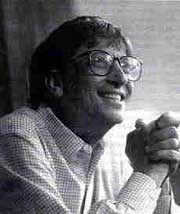Gateway to success
 THE mantra which turned a two-man shoestring-budget operation called Microsoft Corporation into a l7,000- employee-strong global giant, whose sales touch US $6 billion a year, is all there for you to lap kip in The Road Ahead written by the guru himself - Bill Gates. The book is about Gates, his vision and the growth of Microsoft Corporation and other software companies. Reveals Gates, "Luck played a role, but I think the most important element was our original vision". But, the book tencts to get repetitive as Gates goes on cutogising the computer in alrno@t the same words and style in nearly all the chapters. But then, Bill Gates has the licence to do that. Front having wTittert software for tictac-toe, the game - when he was just a 13-year-old - he has become chairperson and chief executive officer of the most successful software company, So, Gates knows what he is talking about.
THE mantra which turned a two-man shoestring-budget operation called Microsoft Corporation into a l7,000- employee-strong global giant, whose sales touch US $6 billion a year, is all there for you to lap kip in The Road Ahead written by the guru himself - Bill Gates. The book is about Gates, his vision and the growth of Microsoft Corporation and other software companies. Reveals Gates, "Luck played a role, but I think the most important element was our original vision". But, the book tencts to get repetitive as Gates goes on cutogising the computer in alrno@t the same words and style in nearly all the chapters. But then, Bill Gates has the licence to do that. Front having wTittert software for tictac-toe, the game - when he was just a 13-year-old - he has become chairperson and chief executive officer of the most successful software company, So, Gates knows what he is talking about.
The existence of an information highway is disputed by Gates. According to him, an information highway in its true sense will take time. Microsoft Corporation is in fact working on the software to make one possible, but the operation is incurring stupendous costs. Just serving users in the us would work out to a whopping LIS $120 billion. But the credit of envisaging a personal computer (Pc) on every desktop - in every home ad office - rests entirely on the qhoulders of Bill Gates. His vision also included making software that would be cheap and widely marketed tremember the Windows 95 blitzkrieg?). It was not just sharp business acumen but such dreams that carried the man forward and made lib, gjV, up his studies and dive into the world of computers. Bill Gates cofounded Microsoft Corporation in 1975 with Paul Allen. The path to success has been short and smooth. Today, Nlicrosoft Corporation is the undisputed leader of the us $120 billion Pc industry, with an estimated 50 million Pcs being sold every year world wide.
The book also reveals the cautious side of Bill Gates' business Instincts. He writes, "What I have said that turned out to be right will be considered obvious and what was wrong may seem humorous." Stich an approach compelled Gates to keel, Microsoft Corporation understaffed initially. Chapter in, which he starts by saving, "Success is a fousv teacher. it seduces smart people into thinking they cannot lose," and end's with the warning that "death can come swiftly to a market leader," really shows his cool-headed attitude. These are some tips from one of Americas richest individuals.
And, if you want to know more about the sci-fi-like home he is building, just get your hands on the book. The house is expected to be the ultimate electronic marvel. Phones keep track of one's location and only the nearest one rings. The television screen in space switches off when one leaves the room. Gates' home will represent the best of what the 21st century technology has to offer. But it is only a concentrated covcr-to-cover reading that will tell you more about this fascinating man and his life. The book is co-authored by Nathan Myhrvold of Microsoft and Peter Rinearson, a Pulitzer prize-winning journalist. Rinearson met Gates in 1982 and wrote the first major newspaper profile of the whizkid and his creation. The language of the book is easy and the style, lucid. The examples given are also very good at elucidating computer jargon so that many can understand and catch a glimpse of the hi-tech world of computers. It is also an effort to encourage the reader to go for the E-world. The book too bestows success on Gates.
